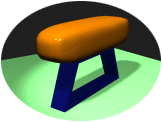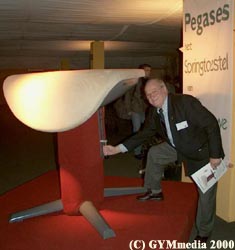| . |
|
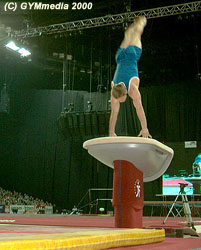
Nemov
to the GYM Gala 2000
|
Russian
Olympic champions Elena Zamolodchikova, Alexei Nemov, Svetlana
Khorkina and others catapulted themselves over the
new prop, which marks a small innovative revolution. Alexei
Nemov, currently ranked #1 in the world, is convinced “that it
will probably take three months at the very most to be able to
fully exploit the advantages of the new vault.”
After years of discussion the International Gymnastics
Federation FIG (see FIG communiqué dated 9 October
2000)
decided to put the old horse in the stable and permitted the
introduction of the vaulting table as of 1 January 2001. The
height of the table, which will be used at the Ghent World
Championships in October, can be adjusted, so it can be used for
both men (1,35m) and women (1,20m). The reasons for this radical
change after almost 200 years can be found in the history of the
apparatus. |
|
Alexander
the Great and his Macedonians are said to have practiced
mounting and dismounting on a wooden horse. In the fourth century
Vegetius describes Roman soldiers practicing on a wooden horse in his
“Overview of the Roman Army”.
| In
the early 19th century, when Jahn,
regarded as the father of gymnastics, was alive, there were
three different kinds of horses on the Hasenheide in Berlin: One
very close to reality with a head and a tail, one made of
leather without a tail but with an ascending neck and the wooden
"Schwingel"
(fescue-grass) a word which F.L. Jahn, who detested the use of
foreign words in German, had created to avoid the originally
French word of Voltegieren.
The latter developed into the Olympic apparatus of pommel horse. |
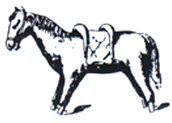
Horse, 1811
|
For
many decades there was no separate vaulting horse, the pommel
horse was simply turned around and gymnasts vaulted over it lengthwise.
The pommels were unscrewed and wooden poles inserted into the holes to
avoid any injuries to the fingers when gymnasts pushed off the horse.
|
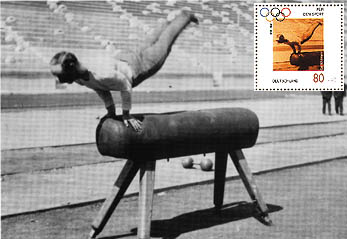
Berlin's Olympic Champion Carl Schuhmann 1896 in Athens
(right, up: Stamp of German Bundespost, 1996)
|
Berlin
native Carl Schuhmann, the most successful German
Olympian in Athens 1896, vaulted over that kind of apparatus…
From then on this horse, which was never meant or constructed
for vaulting over, stood at the end of the 20m runway like a
dangerous and pointed bolt.
Gymnastics saw many dangerous falls and collisions.
When Trent Dimas, who later
went on to take the gold medal on high bar in Barcelona,
seriously injured himself at the 1991 Indianapolis World
Championships, FIG Vice President Siegfried
Fischer (Brazil) called for the creation of a new
vault, which could be used for both men and women.
|
One
of the reasons was that the existing vault for men had a
width of only 35 cms, far to narrow for the gymnasts’ broad shoulders.
|
Former
East German head coach Dieter Hofmann first brought
up this problem in 1983 and has since then addressed the topic
in many lectures and articles, especially since the fact that
the form of the vaulting horse was unsuitable to the male
anatomy became even more evident after the introduction of the
Yurchenko type vaults. Hofmann worked on the creation of Janssen
& Fritsen’s Pegases as a consultant.
The name is derived from the legend of the flying horse "Pegasus"
in Greek mythology and is meant to symbolize the vault into the
next millennium.
Austrian
sculptor, artist and coach Helmut
Hoedelmoser from Vienna created a wooden model in the
early ninties that Esslingen based apparatus manufacturers SPIETH
used to build its Ergojet which they presented to the gymnastics
world during the 1997 Lausanne World Championships.
| . |
 On January 26, 2001 the FIG informed Janssen& Fritsen, Holland
and SPIETH/Germany that their respective models
“Pegases”
and “Ergojet” had been officially certified according
to FIG regulations. On January 26, 2001 the FIG informed Janssen& Fritsen, Holland
and SPIETH/Germany that their respective models
“Pegases”
and “Ergojet” had been officially certified according
to FIG regulations.
|
|

Dieter Hofmann among
Sven Tippelt and Sylvio Kroll (1988)
|
|
|
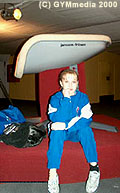
|
In
total, six versions of the vaulting table had been submitted for
evaluation to the Institute of Biomechanics of
Freiburg University by January 2001. So far, the two a.m. have
received the precious FIG diploma. The stars of world gymnastics
will definitely fly into the next millennium of gymnastics over
the new apparatus at the coming world championships.
During
a period of transition, which will last until the market for the
new horse is fully satisfied, gymnasts will still be allowed to
vault over the old horse.
(Eckhard Herholz / gymmedia)
Olympic Champion Elena Zamolodshikova (RUS):
Pegases - a new interesting target |
|
| Sources/Quellen:
"Der Vorturner", 1927/28; "Das Turnjahrhundert
der Deutschen", Götze/Herholz: Beckmanns Sportlexikon
A-Z, Leipzig, Wien 1933; "Deutsche Turnzeitung",
1901; "Neue deutsche Turnzeitung", 1961, J. Leirich;
"Geschichte der Turngeräte", J. Göhler/R. Spieth;
"Mondsalto", gymbooks Verlag 1994, A. Götze/J. Uhr;
"FlickFlack...", Sportverlag Berlin, A .Götze/H.-J.
Zeume; "The History of British Gymnastics", 1988 by
BAGA. |
|
